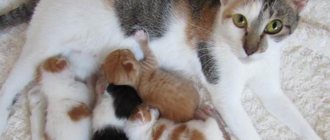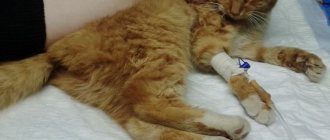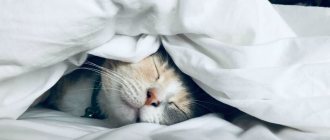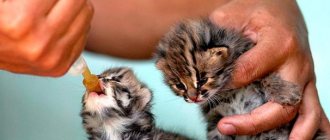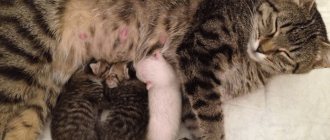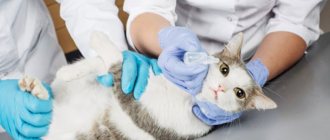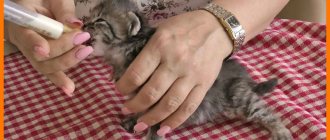Newborn kitten
A newborn kitten is born wet, in a bladder and ideally with an afterbirth on its umbilical cord. If the cat did not rupture the amniotic sac, did not bite the umbilical cord, did not lick the newborn kitten, did not warm it and did not push it to the nipple, you must help the baby. You tear the amniotic sac on the newborn kitten’s face, clean its mouth and nose of mucus (I use sterile gauze wipes for this), cut the umbilical cord, leaving 2-3 cm from the kitten’s belly. Some people process the umbilical cord and tie it with thread, but this is not at all necessary. Wipe the kitten with a soft cloth and drop 1-2 drops of traumatin into its mouth. If a newborn kitten is healthy, it will quickly find the nipple and begin to suckle colostrum - the most important nutrition for a newborn kitten, strengthening its immunity, with the help of which the newborn kitten will receive the cat's antibodies.
A healthy newborn kitten sleeps soundly until three weeks of age and wakes up only to eat. Usually a newborn kitten gets used to sucking on one nipple and is identified by the smell alone.
The video below shows how actively healthy kittens suck milk, which gives them all the substances they need for life.
Usually the cat takes care of the kitten itself, licks it, stimulates bowel movements and urination. If the cat does not lick the kitten, you should use cotton wool moistened with warm water to stimulate the kitten to “pee and poop” before each feeding, massaging the abdomen and genital area.
The temperature of a newborn kitten is 36-37 degrees; if the temperature is lower, the cat repels such a kitten.
A newborn kitten itself cannot warm itself, no matter how hot the room is. A newborn kitten is warmed either by a cat or a heating pad. When hypothermia occurs, the kitten stops digesting milk.
How to help a hypothermic, weak newborn kitten. Such a kitten needs to be slowly warmed up and injected subcutaneously with a 5% glucose solution, and Traumatin should be dropped into the mouth 4-5 times a day. Do this until the cat accepts the kitten. The drug travmatin is well described in the article Drugs for cats. By 6 days of age, kittens begin to shiver, which allows them to slowly regulate their body temperature.
A newborn kitten is born blind. The eyes begin to open by 7-8 days, finally by two weeks.
How to care for and give birth to a pregnant cat
03/14/2013 3 kittens were born. All are grey. The first boy (large) and then two girls (smaller) in the video...
If you are the owner of an unsterilized cat, then you need to know how to deliver her baby. After all, even healthy and strong animals need the help of their owner and are susceptible to complications after childbirth. It is better to prepare for such an event in advance.
The duration of normal pregnancy in cats is 63-66 days. For Siamese this period is shorter. It is possible to determine that a cat is expecting offspring at 3 weeks. The mother cat's nipples turn pink, and sometimes she starts vomiting. At 6 weeks the belly increases.
How to cut a kitten's umbilical cord
A newborn kitten has blue eyes, which begin to change color after three weeks. A newborn kitten 's ears are tightly closed. open by 5-8 days, rise at 3-4 weeks. The sex of a newborn kitten is determined immediately after its birth.
Did you like the article and was it useful? Please share with your friends.
Other interesting articles on our website:
• The kitten screams and squeaks
• Aviary for kittens
• How to train a cat to use the toilet?
• How to stop a cat from pooping outside the litter box
• Childbirth in a Cat
The birth of kittens: how to help a cat during childbirth (memo for cat owners…
If a cat is afraid of its owners and fears for the life of its future offspring, at the first signs of labor it will try to hide where you cannot reach it.
Therefore, you need to think about how your cat’s birth will go from the first day a breeding cat appears in your home.
A properly socialized, educated cat, living in affection, love and understanding, listens to the owner during childbirth, is less nervous, and thus childbirth is easy for both the owners and the mother cat.
British cats usually carry kittens for 65-69 days. Pregnancy is diagnosed 21 days from the average day of mating - the papillae become slightly swollen and reddened. Kittens usually begin to move 3-4 weeks before birth. A day before giving birth, the mother cat's tummy sag.
Girls urgently!! A cat gives birth, what should I do with the kittens’ umbilical cord?????????
In such situations, an experienced owner can help and save the kittens and cat. If the condition is very bad and the help of a veterinarian is required, the owner can alleviate the condition before the doctor arrives. But it is worth remembering that you should not interfere in the process unless there is a clear need, because this can psychologically traumatize the cat and it can eat the kittens.
So, how can you help your cat during childbirth?
If the cat has weak contractions, then you can provoke them by stroking the cat’s stomach and back, change the intensity and strength of the touch, catching the rhythm of the contractions.
If your kitten is stuck in the birth canal, you can help him free himself. You can’t pull a kitten out by the head, because you can break the kitten’s cervical vertebrae; the best way is to pull it by the skin on the neck, by the torso or legs, clasping it with 3 fingers. You need to pull lightly, first to the side, then to the left, alternately from side to side, you cannot pull the kitten perpendicular to the cat’s position, you need to hold and massage the cat’s belly with your hand, you can wet the cat’s fingers and birth canal with Vaseline oil.
Sometimes it happens that the hind legs fall out of the birth canal; you can try to push them back and when the kitten turns and the next contractions, the kitten will take the correct position for birth.
It is important to know that after each kitten is born, the placenta comes out. It is necessary to monitor this, if the number of delivered placentas is not equal to the number of kittens, it is necessary to remove the placenta by hand. Because a placenta that has not been delivered will be a source of infection and can lead to the death of the cat. For such procedures it is necessary to use disposable gloves.
It may happen that the kitten is born in the fetal sac in which it developed in the uterus. As a rule, this shell either breaks on its own or is chewed by the cat. But if this does not happen, then you need to break or carefully cut the bubble yourself, because the kitten may suffocate, but you need to make sure that the liquid does not get into the respiratory tract, so after breaking the bubble, wipe the kitten’s nose.
If the kitten has choked or choked on liquid, then you need to take the kitten in your hands, lift it so that the head is below, but be sure to hold the kitten’s head and lightly shake or press on the kitten’s chest so that the water flows out. Intense rubbing and artificial respiration may also help. To check whether you did everything correctly and whether there is no more danger, listen to the kitten’s breathing, it should be smooth and without wheezing, if this is not the case, repeat the manipulations.
You can also check the condition of the kitten by the color of the tongue; normally it is pink; if cyanosis is observed, then the kitten is experiencing a lack of oxygen. You need to wrap it in a soft, warm cloth, lift it up with its paws, support its head and hold it until the kitten squeaks and inhales normally (the kitten can squeak barely audibly, so be careful).
Cats often have problems with the umbilical cord; the cat may not be able to chew through it or may become distracted if there are many kittens. In this case, it is not difficult to help her. The umbilical cord must be squeezed very tightly, squeezing the blood vessels, it can be tied with thread at a distance of 2 cm from the kitten’s abdomen and cut off with disinfected scissors. The procedure must be carried out using disposable gloves. The cut site must be disinfected with iodine. The umbilical cord should normally look dry after a day, and fall off on its own after 2-3 days.
If a cat has given birth to many kittens, she may begin to lick not only the newborn kitten, but also the one that was born a long time ago, so the kitten may not receive the proper impetus to life. In this case, you need to give the cat a newly born kitten and remove the other one. If the cat stubbornly does not lick the newly born kitten, temporarily put the already born kittens in a box with warm 1.5 liter bottles wrapped in cloth. For them, the most important thing in the first days is to avoid hypothermia.
Easy birth for your cat!
If you decide to do something like breeding kittens or are forced to give birth to your own cat, then you should know some of the features of this process. In principle, nature has decreed that a cat, for the most part, copes with its own childbirth on its own.
If the outcome is successful and your pet is in enviable health, your participation in the birth process will be minimal. If you are not sure that, if necessary, you will be able to provide qualified assistance to your pet, it is advisable to call a veterinarian who will help you cope with this task.
In addition, you can start giving birth by enlisting special literature, which will not only describe the step-by-step processes of labor, but also information on how to cut the umbilical cord in kittens.
In principle, it is not so difficult to understand that your cat is giving birth: she begins to abruptly look for some secluded place. Cats are not social animals, and when it comes to processes such as childbirth and illness, they prefer to endure them alone. Just before giving birth, do not be nervous under any circumstances, since the cat is your favorite, and in any case, your excitement will be transmitted to her, which is undesirable in her situation.
A cat, just like any woman, will initially suffer from contractions, which will quickly turn into pushing. It is worth noting that the duration of labor in a cat is much shorter than in a human. However, you will have to be patient. After the attempts begin, kittens will appear one after another. The kitten is usually followed by the birth of an afterbirth; It is worth noting that quite often the cat itself bites the umbilical cord. Much depends on her breed and disposition.
It is advisable not to touch the cat after giving birth and not to allow strangers near it. If you're wondering when kittens' umbilical cords fall off, it usually happens within 2 or 3 days.
Do not disturb the cat under any circumstances while the kittens are still very small and blind. It is advisable to provide the new mother and her children with a separate nook with a special box into which the cat can easily jump, and from which the kittens, which are too young, will not be able to get out.
You should not look into the kittens’ box once again, and under no circumstances should you pick them up until they begin to crawl out of their birth “nest.” This will make your cat nervous, which is contraindicated for her right now. The most you should do is provide your cat with regular food and a calm environment.
Nonsense. My cat gave birth twice. Before giving birth, she always runs to the kitchen and screams for someone to come to her and support her. When I go after her, she goes into a box in the closet and makes sure that I follow her. She constantly purrs and demands to be petted (she stretches her muzzle towards her hands). After giving birth, I’m only glad to be approached and stroked. She only eats on her own, she comes out once every 2 days. She eats the umbilical cord herself.
The article made a positive impression on me. The author conveyed his point to the readers quite clearly. Personally, I found it interesting. Well. Cats are my weakness, tbh. I'm interested in everything connected with them.
To cut the umbilical cord of kittens, you must have everything sterile. Do not be nervous under any circumstances, as this condition will be passed on to your pet and it will be much harder and more alarming for her. This procedure must also be carried out very carefully.
How to help a cat give birth at home
Lambing or childbirth in cats is a natural physiological process. And usually real “noblewomen” cope with this task themselves. But purebred cats often need help during childbirth from their beloved owner. How to help a cat give birth at home?
The beginning of pregnancy is considered from the day the cat is mated; normally, pregnancy lasts from 60 to 65 days, during which time the cat should give birth. In the last week of pregnancy, it is not recommended to overfeed the cat to make the birth easier. Yes, during this period, cats have a brutal appetite, since she feeds the kittens in the womb, but to feed a cat correctly during pregnancy and lactation , in order to avoid complications. 2-3 days before giving birth, the cat becomes restless, looks for a secluded place, and digs a nest. You must provide such a place for your cat in your home. Immediately on the day of birth, cats' water breaks. On average, cats give birth to 2 to 6 kittens. The length of labor for cats varies from person to person. The first birth of my cat Dunechka lasted 12 hours, the second time only 4 hours. Sometimes cats will give birth to 1-2 kittens, and then there will be a long period of calm, and may give birth to more kittens the next day or a few hours later. This is normal if the cat feels good. If there is any anxiety in the cat, or incessant meowing, it is necessary to consult a veterinarian as soon as possible.
How to help a cat give birth at home .
Prepare everything you need to have at hand: alcohol or vodka, chlorhexidine, sterile wipes, cotton pads, scissors (treat with alcohol), threads. Usually cats are going to give birth in the late afternoon or at night, make sure that you are at home at this time and can help your pet.
Stroke the cat to calm it down. When the kitten starts to come out, make sure that the placenta comes out after the kitten. If the afterbirth remains in the birth canal, inflammation and suppuration are possible. You must not be squeamish if you want to help your cat. If all this unsightly action is not for you, entrust the birth of your cat to professionals. The kittens come out in a bubble, the mongrels break the bubble with their teeth and eat the afterbirth of the kitten. On the contrary, many purebred cats do not do this. You must help the kitten, otherwise he will not be able to breathe and will die. Carefully free the baby from the films, clean the nose and muzzle with a sterile napkin; if he is not breathing, turn the kitten head down and shake lightly. Everything must be done very carefully so as not to break the boys’ necks. Are you breathing or moving? Great, now you need to cut the umbilical cord and remove the placenta. Step back about 3-4 cm from the tummy, tie the umbilical cord with thread, cut off all excess with scissors. Done? Now we give it to the mother cat, let her lick her baby further. Kittens need to be warm and dry, so I hung a lamp at the place where the cat gave birth.
Sometimes cats, especially firstborns, have weak contractions. The interval between contractions is very long, the cat suffers. In such cases, veterinarians prescribe the drug "Oxytocin" to stimulate labor, or if there are complications after childbirth, in the form of bleeding. Your veterinarian will tell you the dosage; it’s different for everyone. But I advise you to buy this drug in advance, before your cat gives birth, just in case, and cases vary. It is normal if your cat has a slight pink discharge within 7 days after giving birth. If the cat is not depressed, eats well, feeds the kittens, then there is nothing to worry about and everything went smoothly. If there is even the slightest suspicion that your cat is unwell, do not hesitate, but contact a veterinarian. Ideally, if you have your own veterinarian at home . which is available at any time of the day or night and to whom you trust the health of your pets.
You can go to the main page of the site. Or by
Should puppies' umbilical cords be cut?
Receiving affection from their pet cat and giving her their attention, most housewives, according to the site Koshechka.ru, simply call a doctor to accompany the birth of their four-legged pets.
The doctor will help the cat herself, cut the kittens’ umbilical cord, and reassure the owner. We love and cherish our pets, but in nature, cats give birth to kittens on their own, they don’t have obstetricians, and no one helps. How does childbirth occur in cats?
Usually, a cat that “walks on its own” will find a secluded place before giving birth where it will be safe. When signs of labor appear, she takes refuge in the chosen place. After the water breaks, contractions begin. The first kitten is born on average an hour after contractions begin.
Cat labor rarely lasts longer than 4 hours. This applies, of course, to healthy cats. In nature or an urban environment, kittens, and even their mother, face many dangers and difficulties; the mortality rate among street cats is high.
It's a different matter for domestic cats! We love them, cherish them, care for them. And when “hour X” approaches, we worry almost more than the mother cat herself.
Pregnancy in cats lasts from 58 to 66 days. Owners should monitor the condition of the future mother cat, and even if there are no signs of illness, the cat is cheerful and easily carries kittens, it would be necessary to show her to a specialist at least once or twice during pregnancy.
Do I need to cut the umbilical cord when giving birth to a dog?
How to properly cut a puppy's umbilical cord?
No, don't. And in general, it’s better not to interfere with this “sacrament.” Don’t disturb the dog, he’s already stressed. Place a bowl of clean water nearby and leave it alone.
Believe me, she will feel more confident without you. Nature laid all the necessary knowledge in her head.
She will gnaw the umbilical cord herself. And he will also “clean up” to the best of his ability in his nest. The placenta eaten by a newly whelped bitch is also not nonsense, but a completely logical action. In this way, the dog replaces the nutrients lost during pregnancy in its body and stimulates milk production.
If you are really worried, be there and just listen. If he fumbles and is silent, then everything is fine..)
Do I need to cut the umbilical cord when giving birth to a cat?
How to properly cut the umbilical cord in kittens?
As for the umbilical cord, the cat will do everything herself. My parents always kept cats, and as far back as I can remember cats always handled childbirth on their own. Or another cat helped them. We've had several of them.
If the cat is purebred like mine, then you will have to cut the umbilical cord yourself and remove the afterbirth. Pedigree cats don’t do this, and I don’t want my cat to eat this bloody stuff, they might get sick from it. Step back a couple of cm from the kitten's belly and clamp or tie the umbilical cord with a thread, cut off the excess with scissors, treat the scissors with alcohol or vodka first, when you cut the umbilical cord, treat the wound with chlorhexidine, the cat will do the rest, lick the kitten.
How to properly cut a kitten's umbilical cord. Umbilical cord
Birth of kittens
In order to help a cat give birth to kittens, you need to buy everything necessary for the birth and prepare the place. These should be cotton or linen towels, which must be washed and ironed with a hot iron.
The normal pregnancy period is 63-65 days, but sometimes it lasts longer up to 70 days. If the cat feels well, eats normally, there are no digestive disorders, and normal movements are observed in the kittens in the mother’s body, then there is no reason to worry.
In such cats, the maternal instinct awakens 1-2 days before giving birth. She often licks other people's kittens or cats as if they were her own.
But there are times when a cat does not behave calmly, and the action of its hormones is delayed. Then the cat, after having rolled, leaves the nest, not wanting to lie with them. In this case, kittens need to be bottle-fed for 24-48 hours until the cat recognizes itself as a mother. It happens that a cat simply does not have enough milk and the kittens have to be fed.
Every cat gives birth differently. Cat birth is subject to the phases of the moon, ebbs and flows. It is important to know the time at which mating occurred and the time according to the lunar calendar in order to calculate the possibility of the onset of labor.
Cats behave differently before giving birth. Some people lose peace 12-24 hours before the onset of labor, others refuse to eat, and others hide in inaccessible places. The body temperature becomes 37, the ears and nose become cold.
Preparing for birth in a cat lasts from 1 to 8 hours. The cervix dilates and the fetus is established. Contractions occur periodically, that is, the smooth muscles of the uterus contract, which helps remove the fetus from the uterus.
The next stage is the opening of the uterus. Next, pushing begins reflexively, that is, contraction of the muscles of the abdominal wall and diaphragm.
Contractions and attempts constantly alternate, as a result of which the fetus is expelled from the uterus. The kittens' airways must immediately be cleaned, all mucus removed with wipes and the umbilical cord cut off.
At the moment of birth, the cat becomes tense, its eyes widen, and becomes attentive to itself. Her body periodically contracts and relaxes. As a result of strong contractions, kittens are born. Between the first contraction and the second, 20-40 minutes pass. After the third or fourth birth of a kitten, contractions may weaken and therefore it is necessary to help by stroking the belly.
The birth process itself is different for each cat. A strong, non-emaciated cat will usually squat down and lean forward slightly before the kitten appears.
Vet clinic
International Scientific Center for Treatment and Rehabilitation of Animals ZOOVET
Free initial appointment with a therapist or surgeon on weekdays from 12:00 to 16:00!*
A veterinary center that emphasizes inpatient treatment and rehabilitation. The center's staff includes rehabilitation doctors, specialists in caring for animals after operations and difficult therapeutic cases.
The international scientific center for the treatment and rehabilitation of animals ZOOVET is one of the few veterinary clinics in Moscow that provides veterinary services to almost any type of animal kept in apartments, be it cats, dogs, rodents, reptiles or birds.
Located in a separate building on 3 floors with a total area of more than 1000 sq.m., the ZOOVET animal treatment and rehabilitation center is today one of the largest veterinary clinics in Russia.
The animal treatment and rehabilitation center includes: therapeutic rooms, two separate operating rooms, a post-operative unit with comfortable enclosures, visual diagnostic rooms, a veterinary pharmacy, and a comfortable and large waiting hall. Thanks to this, at the ZOOVET veterinary center, your pets can take advantage of all the achievements of modern veterinary medicine.
The ZOOVET Animal Treatment and Rehabilitation Center has all the necessary equipment to conduct a complete diagnosis and accurately diagnose pets. The center employs highly qualified visual diagnostic specialists. It has its own veterinary laboratory. allowing laboratory tests to be performed in the shortest possible time.
Special mention should be made of surgical services. carried out at the ZOOVET veterinary center. An anesthesiology team works for each operation. If necessary, a ventilator and oxygen are used. The patient’s condition is monitored by monitors, which allows operations of a high degree of complexity even for patients in serious condition.
The animal treatment and rehabilitation center ZOOVET has emergency veterinary care, a 24-hour dispatch service and several doctors on duty. Emergency doctors are fully equipped with the necessary drugs and consumables. You can also receive the following veterinary services without leaving your home: ultrasound, ECG, collection of material for laboratory tests, as well as some types of surgical operations and other services.
The International Scientific Center for the Treatment and Rehabilitation of Animals ZOOVET maintains close scientific and practical contacts with specialists from veterinary clinics in Europe. Veterinary center specialists periodically undergo internships in foreign veterinary clinics and medical institutes.
The ZOOVET Veterinary Center participates in the postgraduate education program.
The center's specialists are regular speakers at Russian and international veterinary conferences.
The provision of veterinary services in our center is provided on the basis of a Veterinary Services Agreement.
We work around the clock without weekends and holidays!
Our phone
We are always happy to help you!
Preparing for the birth of a cat
After the next kitten appears, she quickly licks it and frees it from its shell. But it happens when a cat gives birth to several kittens after one contraction. Some cats give birth lying down.
There are times when a cat needs help, the kitten gets stuck in the birth canal. To do this, you need to pipette a little warm oil into the vagina.
When a kitten is born, the cat quickly licks it, this helps the kitten breathe. In the case when kittens are born very quickly one after another, it is necessary to immediately rupture the amniotic membrane and use gauze to free the kitten’s nose and mouth from mucus.
A healthy kitten begins to scream.
There are cases when the kitten is large and if the contractions are not intense enough, then it is born almost lifeless. It is urgent to clean his face with gauze, tie up the umbilical cord and rub him with a towel.
If, nevertheless, the kitten does not inhale regularly, then he needs to be given a drop of a respirator - a breathing stimulant.
This kitten needs to be massaged for at least half an hour. It should also be held under a red lamp. If the kitten squeaks a lot, it should be placed with the mother cat.
After a kitten is born and the next one emerges, the mother cat gnaws the newborn's umbilical cord and eats the placenta. The placenta contains substances that stimulate milk retention.
If the placenta does not come out, the umbilical cord should be cut and the placenta will be released at the birth of the next kitten.
When the kitten is very close to the mother and it is very difficult to cut the umbilical cord, you need to massage the umbilical cord with your thumb and forefinger at a distance of 3 cm from the kitten’s abdomen, pinch, cut and disinfect. You can also tear off the umbilical cord with a clean fingernail. You should always have hemostatic cotton with you during childbirth. After 3-5 days, the remainder of the umbilical cord will dry out and fall off.
During birth, a cat can be fed egg yolk with fruit sugar.
The weight of a newborn kitten is from 90 to 120 grams. If a kitten weighs 70 g, then it has no chance of survival. Usually 3 or 4 kittens are born. But it happens that a cat gives birth to a large number of kittens and therefore needs human help.
After giving birth, the cat's uterus leaks and contracts. The corpus luteum dissolves in the ovaries. The mother cat lies relaxed and feeds her kittens. 20 minutes after the start of feeding, the kittens are already full, with rounded tummies and sleep, buried in the body of the mother cat.
Newborn kittens have very sharp claws that are enclosed in a sheath. This sheath on the claws is designed to prevent damage to the fetus in the womb and during childbirth. After birth, the membranes dry out and fall off on their own.
For the first four weeks, the kitten cannot retract its claws, and since they are very sharp, they can injure the eyes. For such cases, you should always have eye ointment - nebacetin.
Forum KOTODOM
Registered:
09 Dec 2009, 15:04
Messages:
11
Age:
30
From:
Moscow
Thanked:
0 times.
Thanked:
0 times.
Good afternoon, dear forum members. I would like to open up a little about the topic of a cat’s first birth, since I came across it the other day. Abyssinian cat 1 year and 3 months. I found a cat for mating (this was the cat’s first mating). The cat had no visible diseases and was in good conditions. So the first mating was successful and on days 65-66 the cat gave birth to 5 kittens. There were no problems with the first kitten that appeared, since the cat chewed off the umbilical cord on both sides; with 2,3,4, I had to cut the umbilical cord myself. 5, the kitten was born dead, but without any visible developmental defects. The kittens were quite active and did not arouse any suspicion at first. The next day in the evening, one kitten had clearly noticeable passivity in its movements and soon (1 hour) it died. After this, since the birth had to take place at the dacha, the cat and kittens had to be transported to the apartment; for this purpose, the carrier was insulated and they were not torn away from the mother. The next day, when I came home from work, another corpse was discovered. After this, it was decided to urgently buy a cat's milk replacer and feed the kittens, but unfortunately, the next day another kitten dies, and in the evening, when the cat carelessly carries the last kitten, she seriously wounds its neck and within some time the last one dies from the wound kitty. Now I would like to say in more detail about the behavior of the cat itself. The birth took place without any serious difficulties; the kittens were born at intervals of approximately 30 minutes. Afterwards, it was noticeable that the cat treated them very negligently, constantly leaving them and coming for 5 minutes about once every 2 hours. The cat’s nipples also raised suspicions; they were swollen, but had a slightly pinkish tint and were flat. An attempt was made to check the cat’s presence of milk, while using hand movements, milk was pumped to the nipples and squeezed out, but no milk was released at all. Also, in these first three days after birth, the cat had rare but very obvious bleeding from the vagina.
So I would like to figure out what could be the reason for this? What do they hope for the next mating? When is the best time to produce it? Is the reason for this being the cat’s small age and immaturity? Do you hope for a more positive result at the next mating? How to prepare for the notoriously difficult pregnancy of kittens?
I see my fault in what happened. I was not prepared for such a difficult set of circumstances; it was necessary to have a cat’s milk substitute and immediately start feeding the kittens, it was necessary to have an electric heating pad to create the required temperature for the kittens in the absence of the mother, etc.
Thank you all in advance for your response.
ActionTeaser.ru - teaser advertising
Where is
We must not forget that the difference in biological species means that the appearance of a cat's navel is noticeably different from a human's. The location of the navel is determined by examining the hair growing on the abdomen. It is located where it grows sparser and shorter. The navel is a small white scar. Of course, it is much easier to find it in a hairless or short-haired pet, but it occurs in any case.
How to find a cat's belly button
If the pet is already an adult, you need to put it on its back and examine the area on its stomach from the ribs to the beginning of the pelvic region. The cat's navel is located between the hind legs, closer to the nipples.
In most cases, detecting a cat's navel is complicated by physiological characteristics, for example, thick hair. Very attentive owners may notice a small spot that resembles lichen. In some individuals the spots may be pink and round, in others they may be irregular in shape.
Finding the navel quickly is possible in a small kitten. However, a good mother helps this part heal faster. Cat saliva contains important vitamins, they have a disinfecting effect. The navel may look like a point invisible to the human eye literally by the age of one month.
Important! The mark from the navel in an adult is practically invisible. This point does not differ in color from the main skin, and is also overgrown with hair.
How to find a cat's belly button
In a healthy cat, the remains of the umbilical cord, just like in a cat, almost completely disappear and should not stick out. This part of the body is noticeable only in newborn cats. The kittens' navel is bright pink and sometimes convex. With age, the navel becomes pale and lighter. In adult cats, this point is covered with hair, making it difficult to detect. Quick detection is possible if the animal has scanty fur or is completely bald.
You can try to lay a calm cat on its back and carefully examine its abdomen, namely the area near the ribs and pelvis. There is usually less fur at the point where the navel is located. The appearance may resemble a small scar. The cat's inguinal nipples can also serve as a reference point.


